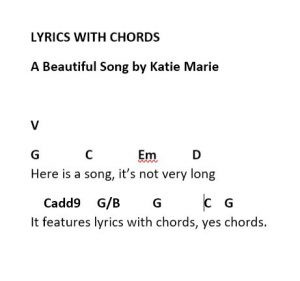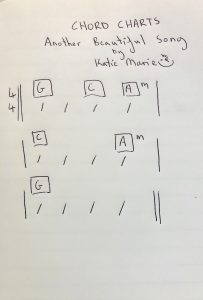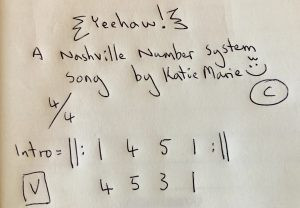Being prepared with accurate charts is essential for smooth and productive recording sessions. Whether you’re a songwriter hiring musicians or a guitarist heading into the studio, clear communication through chord charts saves valuable time and ensures everyone is on the same page musically. This guide explores how to create effective and simple guitar chord charts and lead sheets that will benefit any studio session.
Understanding Chord Charts: Why They Matter in Studio Sessions
In the diverse world of recording sessions, the quality of charts provided to musicians varies greatly. Some songwriters deliver meticulously detailed scores, while others might only offer MP3s as a reference. Drawing from years of experience in numerous recording environments, it’s clear that well-prepared charts are invaluable. They streamline the recording process, allowing musicians to focus on performance rather than deciphering or creating charts on the spot during paid studio time. The foundation of any good chart is understanding the song’s structure.
To simplify and condense chart information, standard abbreviations are commonly used. These act as a musical roadmap, clearly outlining the progression of the song:
- V: Verse
- CH or C: Chorus
- B or BD: Bridge
- Inst: Instrumental
It’s also worth noting regional differences in musical terminology. For instance, musicians from the UK often refer to the bridge as a “Middle 8,” which is abbreviated as “M8” in charts. While some purists might differentiate between a bridge and a Middle 8, in practical studio settings, especially with UK musicians, “Middle 8” typically indicates the bridge section.
Types of Guitar Chord Charts
Once the structure is defined, various charting methods can be employed to communicate the musical content. While these examples primarily focus on melodic instruments like the guitar, the principles can be adapted for drums and percussion, although drum charts often require specific notation for fills and rhythm pattern variations.
Lyrics with Chords
 Lyrics with chords
Lyrics with chords
Lyrics with chords are a favorite among many musicians for their straightforward simplicity and ease of use. As the name suggests, this chart type integrates song lyrics with chord names placed above the words where the chord changes occur. This method is exceptionally user-friendly and requires minimal music theory knowledge, making it an excellent starting point for creating basic guitar chord charts.
However, the simplicity of lyrics with chords comes with limitations. It doesn’t precisely indicate the rhythmic placement of chords within a measure, which can be crucial for songs with more intricate rhythmic structures. Despite this, for songs with relatively straightforward chord progressions and rhythms, lyrics with chords offer a quick and effective way to get your musical ideas across. This is particularly useful in initial songwriting stages or for musicians who prioritize lyrical content and harmonic changes over detailed rhythmic notation.
Standard Chord Charts
 Chord Charts
Chord Charts
Standard chord charts provide a more rhythmically precise representation of the music compared to lyrics with chords. They typically display chord names arranged in measures, reflecting the song’s time signature. The example shown is in 4/4 time, indicated by four beats per bar. Beneath the chord names, rhythm markings are often used to specify the duration of each chord within the measure.
In the example, the first bar shows ‘G’ with two rhythm markings, ‘C’ with one, and ‘Am’ with one. These markings, often simple dashes or lines, tell the musician how many beats to play each chord. In this case, G gets two beats, C gets one beat, and Am gets one beat, totaling four beats for the 4/4 measure. Another common approach to rhythm marking is to assume the first chord in a measure starts on the first beat, and subsequent markings indicate the duration from there. For instance, in another variation, both G and C could have two rhythm markings each, implying each chord is held for two beats within the bar. Standard chord charts are a step up in detail, offering rhythmic clarity while remaining relatively easy to read, making them suitable for a wide range of musical scenarios, especially when rhythmic accuracy is more critical.
Nashville Number System for Guitar Chords
 Nashville Number System
Nashville Number System
The Nashville Number System is a streamlined and versatile method for charting songs, particularly valuable in situations where key changes might be needed on the fly. Its beauty lies in its simplicity and adaptability, allowing for instant transposition without rewriting the entire chart. This is incredibly useful in songwriting and arranging sessions where the key of a song is still being determined.
How It Works: Instead of using chord letters like G or C, the Nashville Number System uses numbers to represent chords within a key. In a major key, each number corresponds to a scale degree and chord quality:
- 1: Major
- 2: Minor
- 3: Minor
- 4: Major
- 5: Major
- 6: Minor
- 7: Diminished
In a minor key, the qualities shift:
- 1: Minor
- 2: Diminished
- 3: Major
- 4: Minor
- 5: Minor
- 6: Major
- 7: Major
For example, in the key of C major (C-D-E-F-G-A-B), a two-bar verse progression might be written in numbers as:
[ 1 1 4 5 ] [ 1 1 2 2 ]
Translating this to chords in C major, we get:
[ C C F G ] [ C C Dm Dm ]
The real power of the Nashville Number System becomes apparent when transposing. If we decide to shift the same progression to G major, the number chart remains unchanged:
[ 1 1 4 5 ] [ 1 1 2 2 ]
But now, applying it to the G major scale and chord qualities, the progression becomes:
[ G G C D ] [ G G Am Am ] (Note: In G major, the 2 chord is Am, not Adim as originally stated in the source for minor key 2nd. In major key context, 2nd is minor. Correction made for accuracy)
The Nashville Number System also includes symbols for rhythmic nuances, such as a diamond indicating a sustained chord or a “^” for a staccato or cut-off chord. While some prefer traditional notation for such details, experimenting with these symbols can be beneficial. This explanation covers the foundational aspects of the Nashville Number System. Further exploration will reveal its depth and efficiency for professional musicians, especially guitarists working in diverse musical contexts.
Full Music Scores
Full music scores represent the most comprehensive and detailed method of charting music. They can encompass every aspect of a song, including melody lines, precise rhythms, harmonies, and articulations. If complete musical detail is required, a full score is the ultimate solution.
However, it’s important to consider the audience. While musicians within classical music traditions are highly proficient in reading full scores, many contemporary musicians, particularly outside of formally trained circles, may not be as comfortable with standard music notation. That being said, many professional studio musicians, especially those with broad experience, can navigate music scores effectively. For projects demanding meticulous control over every musical element, and when working with musicians who are fluent in music notation, a full score is the most precise way to communicate musical intentions note for note. For guitarists and musicians aiming for the highest level of accuracy and detail in their charts, especially for complex compositions, understanding and utilizing full scores can be a valuable skill.
Tips for Creating Effective Guitar Chord Charts
Beyond choosing the right type of chart, several best practices can enhance the clarity and usability of your guitar chord charts:
- Keep it Simple: Prioritize clarity over complexity. Avoid unnecessary details that can clutter the chart and confuse musicians. Focus on the essential information needed for performance.
- Use Clear and Legible Formatting: Choose a font and layout that are easy to read at a glance, especially in potentially dimly lit studio environments. Clearly distinguish between chord names, lyrics, and rhythmic markings.
- Accuracy is Key: Double-check all chord names, rhythms, and structural markings for accuracy. Errors in charts can lead to wasted studio time and frustration.
- Provide Chord Voicings (Optional): For guitarists, especially in genres where specific voicings are important, consider adding suggested chord voicings, particularly if unusual or specific sounds are desired. This can be indicated through diagrams or annotations.
- Include Song Sections and Repeats: Clearly mark verses, choruses, bridges, and instrumental sections. Use repeat signs or instructions (e.g., “Repeat Chorus 2x”) to condense the chart and make it easier to follow song structure.
- Consider a Lead Sheet: For songs with significant melodic lines, especially for instrumental parts or vocal melodies, combining a chord chart with a single-line melody notation (lead sheet) can be highly effective. This provides harmonic context along with essential melodic information.
Conclusion
Creating effective guitar chord charts and lead sheets is a vital skill for songwriters, composers, and musicians working in studio environments. By understanding the different types of charts available—from simple lyrics with chords to detailed full scores—and applying best practices in chart creation, you can ensure clear communication and efficient recording sessions. Whether you opt for the simplicity of lyrics and chords, the rhythmic precision of standard chord charts, the versatility of the Nashville Number System, or the detail of full scores, the goal remains the same: to provide musicians with the information they need to perform their best, saving time and maximizing creativity in the studio. Experiment with these methods and find what works best for your workflow and the musicians you collaborate with. Happy charting!
